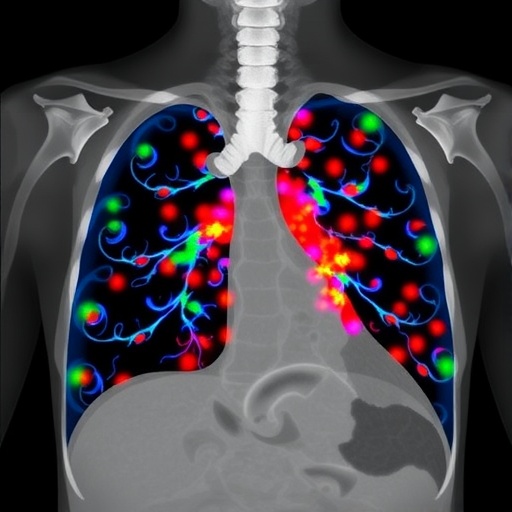In a groundbreaking development for neuro-oncology, a consortium of clinicians and researchers from the Johns Hopkins Kimmel Cancer Center alongside four other distinguished institutions have unveiled novel methodologies that dramatically enhance what can be learned from small glioblastoma tumor biopsies. Glioblastoma, an especially aggressive and lethal form of brain cancer, has traditionally posed significant challenges to oncologists seeking to understand its complex biology. This latest research signals a paradigm shift by demonstrating that even minimal tissue collected through stereotactic needle biopsies can yield a remarkably detailed molecular and cellular landscape, potentially revolutionizing treatment approaches for brain tumors and beyond.
The study, published in the April 28 issue of Nature Communications and supported by funding from Break Through Cancer, leverages an integrative suite of advanced laboratory techniques. Historically, tissue samples from glioblastoma patients were limited in quantity and typically examined only for basic pathological diagnosis. Now, researchers have employed single-cell RNA sequencing, transcriptomics, metabolomics, proteomics, and comprehensive immune profiling on these small biopsies. Such multiplexed analysis allows for unprecedented insight into not only the tumor cells themselves but also the intricate interactions within the tumor microenvironment, including immune cell infiltration and metabolic adaptations of cancer cells.
Stereotactic needle biopsy, the procedure used to harvest the tumor specimens, is minimally invasive yet traditionally limited because it requires sedation and carries surgical risks. Consequently, tissue sampling was usually performed only once or twice during the course of treatment—often at diagnosis and, occasionally, at treatment completion. However, this research introduces a novel protocol where an oncolytic virus is injected directly into the tumor during the biopsy procedure, aimed at selectively killing glioblastoma cells. Simultaneously, tissue is harvested and subjected to extensive molecular profiling. This approach not only offers therapeutic intervention at the time of biopsy but also maximizes the scientific value obtained from each surgical event.
Central to this endeavor is the ability to perform detailed characterization of the tumor’s heterogeneity. Glioblastoma is notorious for its cellular diversity and resistance to therapy, with subpopulations of cells that drive progression and evade treatment. Utilizing single-cell RNA sequencing, the researchers deconvoluted these subpopulations on a cell-by-cell basis, revealing specific gene expression profiles that correlate with treatment sensitivity or resistance. This granularity paves the way for patient-specific therapeutic strategies that can be refined over time with repeat biopsies, a practice previously deemed impractical due to concerns about risk and limited information gain.
In addition to transcriptomic data, the inclusion of metabolomics and proteomics offers valuable insight into the biochemical pathways sustaining tumor growth and survival. By mapping the metabolites and proteins expressed in tiny tissue samples, the investigators could pinpoint dysregulated metabolic networks and potential vulnerabilities. These multidimensional datasets enable a holistic view of tumor physiology, far surpassing what was achievable with standard histopathological assessments.
Immune profiling emerged as another critical component of this study. Glioblastoma has a notoriously immunosuppressive microenvironment that hampers the efficacy of immunotherapies. By dissecting the immune cell populations present within the biopsy tissue, researchers identified distinct immune signatures that could inform new strategies to modulate the brain’s immune milieu. Understanding these immune dynamics is crucial, as current therapies have limited success in overcoming the tumor’s defensive barriers.
A particularly innovative aspect of the study was the transplantation of patient-derived tissue samples into mouse models, creating in vivo environments that faithfully recapitulate human glioblastoma biology. These patient-derived xenografts enable longitudinal studies to observe tumor evolution, response to different therapies, and mechanisms of resistance in a controlled setting, thus empowering researchers to test novel treatments before clinical application.
Dr. Matthias Holdhoff, co-director of the Brain Cancer Disease Group at Johns Hopkins and a study co-author, emphasizes the urgency of advancing treatment options for glioblastoma. “One of the major frontiers in oncology,” he explains, “is to uncover why some treatments succeed while many fail. This can only happen with a far deeper understanding of the tumor’s biology, obtained through comprehensive analysis of the tissue itself.” This statement underscores the critical role that advanced molecular characterization of biopsies will play in personalized medicine for aggressive cancers.
Meanwhile, Dr. Chetan Bettegowda, director of the Metastatic Brain Tumor Center and another key contributor, reflects on how this research fundamentally challenges prior clinical assumptions. “Historically, repeat biopsies were avoided because clinicians wondered what additional value they could provide beyond the initial diagnosis,” he states. “Our findings prove that each biopsy offers new and actionable data that can reshape patient management, not only for brain cancers but potentially for other solid tumors as well.”
The collaborative nature of this study reflects its wide-reaching implications. Alongside Johns Hopkins, leading cancer centers including Memorial Sloan Kettering in New York City, Dana-Farber in Boston, MD Anderson in Houston, and the Koch Institute at MIT partnered to establish robust analytic platforms and share cutting-edge expertise. This consortium approach ensures that the techniques pioneered here will be refined, validated, and translated into clinical protocols expeditiously.
Beyond advancing glioblastoma research, the methodologies showcased in this study represent a significant leap for oncology as a whole. The integration of multi-omics analysis derived from minute biopsy samples heralds a future where tumor monitoring becomes dynamic and iterative rather than static. Such refinement promises to tailor interventions with greater precision, continually adapting to tumor evolution and therapeutic response.
The prospect of coupling therapeutic viral injections with expansive molecular profiling within the same surgical session also foresees a streamlined clinical workflow, minimizing patient burden while maximizing clinical and research yield. This dual-purpose approach exemplifies translational medicine at its most impactful, where diagnostic innovation dovetails seamlessly with emerging treatment modalities.
As this research progresses, it is poised to accelerate the development of personalized, adaptive therapies that are desperately needed in glioblastoma and other cancers characterized by heterogeneity and treatment resistance. It redefines what can be achieved with limited tumor specimens and paves the way for a future in which repeat biopsies are not just safe but essential for guiding next-generation cancer care.
Subject of Research: Glioblastoma tumor biology and molecular characterization through multi-omics analysis of small needle biopsies combined with oncolytic viral therapy.
Article Title: Integrated Multi-Omics Analysis of Glioblastoma Needle Biopsies Reveals Novel Insights into Tumor Biology and Therapeutic Vulnerabilities
News Publication Date: April 28, 2025
Web References:
Johns Hopkins Kimmel Cancer Center: https://www.hopkinsmedicine.org/kimmel_cancer_center/
Nature Communications article: https://www.nature.com/articles/s41467-025-58452-8
References:
Holdhoff, M., Bettegowda, C. et al. (2025). Integrated Multi-Omics Analysis of Glioblastoma Needle Biopsies. Nature Communications.
Image Credits: Not specified in source content.
Keywords: Glioblastoma, brain cancer, needle biopsy, single-cell RNA sequencing, transcriptomics, metabolomics, proteomics, immune profiling, oncolytic virus, patient-derived xenografts, tumor microenvironment, personalized oncology
Tags: advanced laboratory techniques in oncologybreakthrough cancer research initiativescomprehensive immune profiling methodsenhancing glioblastoma treatment strategiesglioblastoma researchglioblastoma tumor microenvironment analysisintegrating multiple analytical approaches in cancermetabolomics in brain cancer studiesneuro-oncology advancementsnovel methodologies for tumor biopsiesproteomics and cancer treatmentsingle-cell RNA sequencing for tumors





